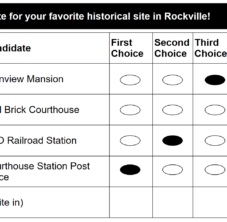The effort for election reform continues (oh so slowly) in the region, and it passed a major milestone on June 20. That was the day Democratic voters nominated primary winners for the Arlington County Board—and they used ranked-choice voting.
Before explaining why this is so significant, let’s refresh how we elect our own at-large members on the county’s County Council. There are four such members, and they are elected by plurality win. The top four vote-getters are the winners. (This is true in the Democratic primaries as well as the general elections.) The fault with this method is that a small group of people elects all the winners. None of the sitting at-large members won a majority of votes in the Democratic primaries, but a small group of voters (approximately 80,000 out of 650,000 eligible) elected all four at-larges! The policies the at-large members promote in education, housing, taxation, economy, transportation, and environment are the expressions of those 80,000 voters and no more.
Because a small group of voters elects all the winners, at-large elections by plurality win have been denounced by Supreme Court judges and voting activists since 1788.
During the Question D referendum to replace the at-large representatives with district members, the matter of ranked-choice voting was mentioned. In ranked-choice voting, voters mark on their ballots their first-choice, second-choice, and third-choice winner. On election day, if a particular candidate does not win a majority, the counting starts again by eliminating the last place candidate and counting those voters’ second-choice candidate. Watch the following 90-second video.
The clear advantage of ranked-choice voting is that a small group of voters does not elect all the winners. The outcome in Arlington proves this. The big issue there is zoning and affordable housing, and the two winners were from different sides of the issue. Summarizing the excellent article in the Washington Post:
Under the ranked-choice system, Democratic voters nominated one candidate from the camp to rezone, and another candidate to keep the existing zoning. Both candidates praised the ranked-choice system, noting that it gave representation to two camps of a community that had been split on affordable housing.
Arlington proved it: ranked-choice voting prevents a small group of aggressive and entitled voters from easily electing plurality winners. Other Virginia jurisdictions will now be examining ranked-choice voting as well. We’ll continue to work for this reform in exclusionary jurisdictions such as Montgomery County’s County Council and its Board of Education.



